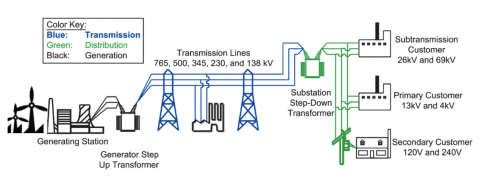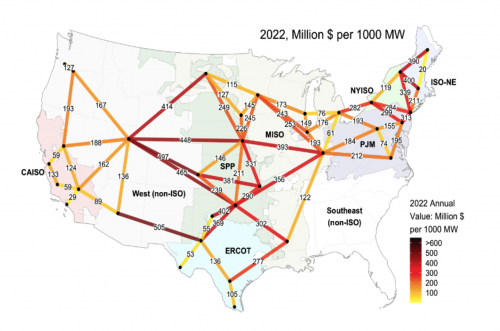Electrical Transmission
This training reviews how electrical transmission will contribute to a clean and stable electric grid. This training is part of a series of trainings on achieving a clean electric grid and some of the main technologies that will get us there.
Background on electrical transmission
Long-distance transmission lines transport electrical energy from where power is produced to where it’s used. This is done at high voltages (‘voltage’ is basically a measure of the pressure pushing the flow of electricity) to minimize energy losses over long distances. Electrical transformers are used to increase or decrease electrical voltages as needed. The electricity traveling along long-distance transmission lines usually exceeds 100,000 volts, while the electricity coming out of a home electrical outlet ranges from 110 to 240 volts.
Long-distance transmission lines are different from local electrical distribution lines, which transport lower-voltage energy within towns and cities from local substations to end users.

U.S. Department of Energy diagram of an electric power system
Most electrical transmission lines are made of aluminum (which is significantly cheaper and lighter than copper), sometimes reinforced with steel. The lines are usually run overhead across large transmission towers, although sometimes we bury them underground.
How transmission supports a clean and stable electric grid
Transmission lines are a critical component of a decarbonized electrical grid. Energy systems experts project that most of the power in a clean grid will be supplied by solar panels and wind turbines thanks to their low cost. Big solar and wind farms tend to be located in rural areas where there are relatively cheap tracts of land available. But most consumers are located in large metropolitan areas. Transmission lines are needed to transport the electricity long distances from the solar and wind farms to the consumers.
Interconnecting neighboring regions with transmission lines can also help make the grid more stable and reduce electricity costs. That’s because while the weather at a given time in one region might be mostly calm or cloudy (and thus lack solar or wind energy), the weather in a neighboring region might be sunnier and/or windier at the same time. As the Department of Energy noted in a February 2023 report, the more regions we can connect with transmission lines, the more they can share resources and stabilize the grid. That also saves money by requiring the construction of fewer local power plants.
The annual cumulative value of a hypothetical 1000 megawatt transmission link, from Berkeley Lab.
Issues with Transmission
Due largely to a slow permitting process, it takes a decade on average to complete a new transmission line project in the U.S. One challenge is that transmission lines spanning multiple states require permitting approvals from each individual state, unlike interstate natural gas pipelines, which can be approved by a single federal regulatory agency – the Federal Energy Regulatory Commission (FERC). Deciding who pays, and how much, for a transmission line can also bog down the planning process. These bottlenecks can be eased through clean energy permitting reform and new FERC rules.
Local opposition to transmission line siting (‘not in my backyard,’ or NIMBY) can also create roadblocks. People sometimes consider overhead transmission lines and towers unsightly, and they may not benefit from the electricity being generated far away and transported through their property to be used elsewhere.
Transmission lines also have an environmental impact on the land that they traverse. For example, their construction could impact local wildlife. For this reason, planning to site transmission lines along routes minimizing their environmental impact is important.
Downed transmission lines can also spark wildfires, especially in drought-prone areas like California. That problem can be mitigated by burying lines underground.
How much could transmission contribute to a clean and stable electric grid?
A 2021 Princeton Net-Zero America report estimated that reaching net-zero emissions in the U.S. will require two to five times more electrical transmission in 2050 than exists today. The animation below illustrates the amount of wind and solar energy and transmission lines the U.S. will need to add every decade 2020 through 2050 in one net-zero scenario.

Over the past decade, the U.S. has only expanded its transmission infrastructure at a rate of 1% per year. That will need to more than double between 2023 and 2030 to unlock the full potential climate pollution reduction from the Inflation Reduction Act.
Other FAQs
Why not bury the lines underground?
Burying transmission lines underground offers some benefits, like eliminating the risk of sparking wildfires, having less visual impact (and thus less NIMBY opposition), and protection against weather. In California, Pacific Gas & Electric is planning to bury 10,000 miles of transmission lines in high wildfire-risk areas.
But insulated cable and excavation costs are expensive. Burying transmission lines underground can cost 5 to 10 times more than building overhead lines (although one analysis concluded that underground high-voltage direct current lines could be as cost-effective as many existing overhead lines), and underground lines are also more difficult and costly to repair and upgrade. They also take more time to install, and while they’re protected from weather like strong winds, underground lines are more susceptible to flood and excavation damage.
Why not put transmission lines along existing rights-of-way like highways?
A “right-of-way” (ROW) is a type of easement that has been granted by landowners to build transportation or other infrastructure on a piece of land. Building transmission lines along existing ROWs like highways and rail lines can overcome many of the issues with transmission such as NIMBY opposition.
One challenge is that a lack of space along the existing infrastructure on the ROW often means that the transmission lines would have to be buried underground. As noted above, that can be a costly process. Another challenge is that some locations prohibit the installation of utilities along ROWs, and so laws would need to be changed to allow it.
In short, siting transmission lines along existing ROWs is one potential solution, and it’s one that the Department of Transportation is providing guidance on. But there remain challenges to overcome.
Why not use other solutions like distributed energy and less transmission?
In theory if we deploy more energy sources that are located near consumers, or if we use more battery storage, or more firm power generation (i.e. geothermal power, hydroelectricity, nuclear power, and bioenergy and gas with carbon capture), then we might need less long-distance transmission to ensure grid reliability. For example, if we have lots of solar panels on rooftops and parking lots, lots of batteries and other energy storage methods, and big reliable power sources like geothermal and nuclear plants, we’ll have more energy closer to where we need it, so we might not need as much transmission.
But completely decarbonizing the electric grid will require a lot of all of the above. That means lots of solar panels distributed in cities, lots of firm power sources, lots of battery storage, and lots of wind and solar farms connected to the grid through long-distance transmission. That’s why the amount of transmission needed in the scenarios considered in the 2021 Princeton report ranged from double what exists today to five times as much. It depends on what mix of solutions ends up being the most economical and feasible to deploy.
Who controls oversight of transmission line permitting?
The permitting of transmission lines is overseen by a combination of federal, state and/or local governments. Locally, communities and landowners have to consent to their construction. States also generally have jurisdiction over the permitting and siting of electric transmission lines. And if a large transmission project might have a significant impact on the environment and wildlife or run through federal land, they may require federal permits that are overseen by a variety of federal agencies.
As a result, long-distance transmission lines running through multiple states can require a plethora of federal, state, and local permits. This process is in stark contrast to the approval of interstate natural gas pipelines, for which FERC can be the lone agency overseeing the permitting process. As a result, the federal permitting process for interstate natural gas pipelines takes only about half as long as the permitting of interstate electrical transmission lines. CCL supports proposals that have been advanced to grant FERC greater oversight of the interstate transmission permitting process to alleviate this difference.
Instructions for printing this page on CCL Community.
